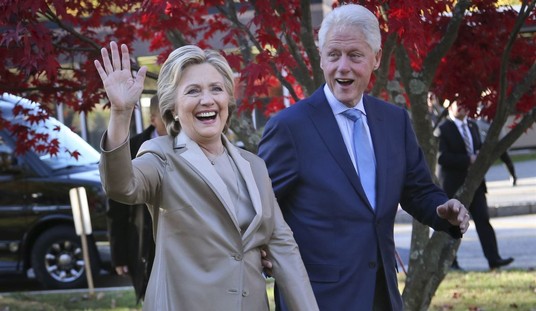Liberal groups like the Southern Poverty Law Center (SPLC) track “hate crimes,” and conservatives rightly remember crimes of malice committed against them, but the vast majority of crime is not motivated by animus towards people groups — but by personal anger. Carl Chinn, founder of the Faith Based Security Network, has catalogued deadly force attacks against religious organizations for nearly 20 years, and found that “hate” only inspired a small percentage of these attacks.
“The animus that results in deadly violence is one of the lowest reasons that we see deadly violence,” Chinn told PJ Media. While this does not prove that animus towards people groups (racism, sexism, Christianophobia, et cetera) does not exist, it does show that the more likely motive for deadly violence — at religious organizations at least — is something else.
According to his statistics, only 76 out of the 1,705 deadly force attacks against religious organizations (including all denominations of Christianity, Muslim, Jewish, Buddhist, etc.) since 1999 have been inspired by animus against a specific people group (be it racial or religious or something else). Such incidents make up only 5.87 percent of the deadly attacks on churches.
Chinn remarked that “the Southern Poverty Law Center is a flagship for what’s wrong with the study of hate crimes.” The SPLC brands mainstream conservative and Christian groups “hate groups,” and focuses on instances of apparent animus against people due to their skin color, sexual orientation, or other characteristics. The group has been known to fall for “hate” hoaxes and to fail to correct the record afterwards.
“I do not track hate crime,” the statistician remarked, noting that it is hard to keep “hate crime” reporting unbiased. “There’s a lot of misreporting in this business, because people look at it with colored lenses.”
“I don’t agree with the Southern Poverty Law Center at all,” Chinn explained. “When somebody calls the Family Research Council (FRC) a hate group, I discredit them.” SPLC marked FRC a “hate group” in 2007, and their “hate map” inspired a terrorist attack on FRC in 2012. SPLC has not removed FRC from its list of “hate groups” or from its “hate map.”
The underlying problem goes far beyond the SPLC, however. “We want to chase over all this sexy stuff, the terrorist attacks and the bias, but the truth of the matter is, it is anger in mankind towards his fellow man that gets people hurt,” Chinn explained. “More than anything, it’s anger.”
“It’s fun to join with the others in your tribe that are talking about terrorism coming to America or talking about hate crimes,” the crime statistician said. “Those are tribal turf wars, and the truth of the matter is, those aren’t what’s getting people hurt. It’s the anger that’s getting people hurt — anger on a local level between two or more people.”
According to his data, robbery (25.97 percent), domestic violence spillover (16 percent), personal conflict (13.6 percent), mental illness (11 percent), and gang activity (8.89 percent) were much more likely motives for deadly force attacks in churches than any form of bias. While a full 57.2 percent of attacks involved a firearm, Chinn warned that this number is likely inflated because it includes incidents where a police officer shot the perpetrator.
Chinn presented another reason to question “hate crime” statistics.
“If you look at the FBI crime reports for 2007, they say that there were 9 fatalities resulting from hate crime,” he noted. “About half of those were against homosexuals and half of those were against race. None were religion-based.”
Yet in that same year, on December 9 to be exact, a killer attacked the YWAM in Arvada, Colo. The shooter killed two and wounded others, then disappeared into the night.
“He got on the Internet, he posted 13 suicide diatribes,” the statistician recalled. He paraphrased one of those diatribes: “I’m going out to make a stand against this sick religion. Christian America, this is your Columbine.”
This shooter came to Chinn’s church (New Life Church in Colorado Springs) and killed two, wounding others. “That was not listed as a hate crime because we’re the wrong religion,” he quipped.
“You can kill Christians and it won’t be a hate crime,” Chinn added, bitterly. “But you can paint a swastika on a Jewish center, and it’s a hate crime. Or you can rip down a Black Lives Matter sign from a black church, and that’s a hate crime.”
Chinn began researching deadly force attacks on religious organizations in 1997, “trying to find what was the most likely thing to occur at a faith-based organization.” He said he uses various sources, from news media to court documents, to capture as many events as possible. He follows incidents over the long haul, because “sometimes it’s a year or two before somebody’s arrested and in some cases until somebody dies.”
“Most crime goes unreported,” Chinn explained. In fact, his original goals were much more ambitious — he wanted to catalogue all attacks on religious organizations, but he realized that “unless it’s a murder event or has the potential of murder, the chances of finding anything on it are none.”
In 1999, he narrowed the parameters of his study to “how often does a deadly force level of violence happen at a faith-based organization?” His data traces back to that year, but with the rise of the Internet, his ability to catalogue events became more reliable around 2009.
“If it’s a deadly force incident, if it’s got the potential or the real-life actions of a homicide or a suicide, that would affect your security team, so I put it in my report,” Chinn told PJ Media.
For a long time, the statistician kept the numbers to himself. Then one day in 2005, he grew so frustrated at false media coverage that he literally screamed at his television.
“I was watching the news in March of 2005 when the Brookfield Wisconsin killer told the pastor in anger on a Sunday morning service, ‘I’ll be back.’ He came back in with two guns, killed the pastor, the pastor’s son, and four others,” Chinn recalled. “This news reporter said this was the fourth shooting in a church in America. I yelled at the TV. My wife was knitting and I’m going into this tirade. ‘Where do they get this nonsense?!'”
His wife encouraged him to do something about it, and he finally published his data online. He published a book, “Faith Invades Sanctuary,” about the threats to religious organizations, in 2012. Last year, he filed the paperwork to establish the Faith Based Security Network, a non-profit dedicated to preparing churches and other faith organizations for self-defense.
According to Chinn’s records, 2017 was the worst year for deadly force attacks against religious organizations, even before the Sutherland Springs church shooting last November that claimed 27 lives.
“Even before Sutherland Springs, we were set to have a record high, and a scary record high,” he told PJ Media.
“Something has changed in America,” Chinn warned, suggesting a larger spiritual crisis. “You can’t start saying that there’s no difference between good and evil and not see moral decay.”
“There’s a whole agenda out there that says there’s no such thing as moral decay but a child undisciplined is an angry child,” the statistician noted. “Maybe that’s what we have going on in America. Maybe we have forgotten how to discipline ourselves.”
“Darkness in the human heart, that’s what it boils down to, and in America we’ve said there’s no such thing as an evil heart, it’s just preference and lifestyle,” he lamented. “No, it’s not. There’s good and bad in the human heart.”
If anyone would doubt that, Chinn pointed to child victims of sexual abuse. Among other things, his organization helps churches set up policies to protect children’s safety. “A pedophile has many victims before he has a record. You’ve got to have policies in place that are so sound, even if you had a pedophile serving in your ministry, he would have no opportunity to hurt a child.”
Although “hate” motivates comparatively few attacks in churches, Chin upbraided Democrats for stoking animus and anger in general.
“I try so hard not to sound political, but when you’ve got leaders of one party saying, ‘We won’t be civil until we rule the House,’ that’s like the tantrum of a toddler,” Chinn quipped, referencing comments from Hillary Clinton. “I don’t know how an adult could say that. I don’t know how an adult can say some of the stuff Trump does, either.”
While Democrats — and Clinton in particular — were the intended victims of the recent string of attempted bombings this week, that does not erase the fact that Rep. Maxine Waters (D-Calif.) has encouraged constant harassment of Republicans, as have Sen. Cory Booker (D-N.J.), Eric Holder, and Hillary Clinton.
Shane Mekeland, a Republican candidate for Minnesota’s state House, blamed Democrats for inspiring the incivility that led a man to punch him out of nowhere, leaving him with a concussion and the inability to campaign outside without getting a headache.
If anger and lack of discipline, rather than “hate” stemming from one agenda or another, is the main driver of most attacks, then Americans need civility more than “bias” training. “Hate groups” are not the real problem — the human heart is. Evil cannot be eradicated from the human heart, but Americans can learn the discipline required for civility.
Follow the author of this article on Twitter at @Tyler2ONeil.









Join the conversation as a VIP Member